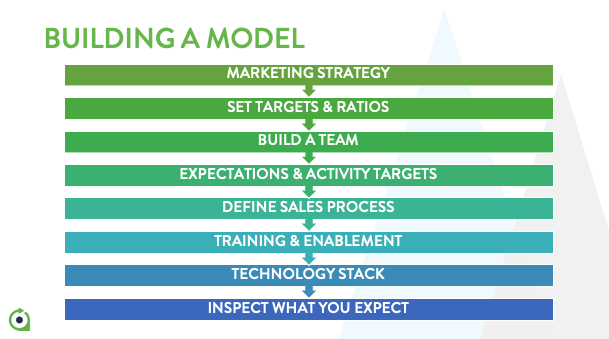A predictable revenue model is an invaluable tool for business growth. It can help you establish benchmarks, identify which sales strategies are and are not working, and grow your revenue significantly over time.
But how exactly do you set up a foolproof system to execute marketing and sales initiatives? And how do you enable your team to maintain the model efficiently?
If you’re struggling to build a revenue model that fosters year-over-year growth, Rev.io can help you get back on track.
What Is A Predictable Revenue Model?
A predictable revenue model allows you to forecast estimated future sales based on historical trends. By measuring your potential revenue as an ongoing cycle and not by individual sales or deals, you can begin to identify ways to increase your revenue and improve your efficiency.
So, how exactly do you build a model that virtually guarantees success? Reference our eight-step guide below to jump-start your company’s YOY revenue growth:
- Evaluate & Implement Your Marketing Strategy
- Set Targets & Calibrate Ratios
- Build the Right Team
- Set Expectations & Track Activity
- Define Your Sales Process
- Prioritize Training & Enablement
- Choose the Right Technology Stack
- Inspect What You Expect

How To Implement A Predictable Revenue Model
To create a predictable revenue model, start by evaluating your marketing strategy to ensure it aligns with your business goals. Set clear sales targets and regularly track performance metrics. Build a dedicated team, define your sales process, and prioritize continuous training and enablement. Implement the right technology stack and consistently measure and adjust your strategies for optimal results.
1. Evaluate & Implement Your Marketing Strategy
The first step toward developing a predictable revenue model is building or honing your marketing strategy.
Creating a New Marketing Strategy
Start by establishing your desired positioning. This is done by identifying your target customers, their most critical needs, and the unique solutions you offer. Then, craft engaging content across owned, paid, and earned media channels that speak to how your products or services can solve your customers problems.
Perform competitive research to understand how you can best differentiate your company from others in your industry. Finding your niche within the larger ecosystem of your industry is a massive step toward making predictable revenue possible.
Evaluating Your Existing Marketing Strategy
If you’re an established company, it’s time for a marketing audit. Review all of your multi-channel marketing efforts and assess their cost-effectiveness and overall results.
Reallocate your budget from strategies that aren’t working to those that are. Look critically at your branding, customer journey, and common barriers to conversion. Consider your closest competitors and brainstorm new initiatives, products, services, or approaches that help you define your own niche.
Whether you’re taking a look at your existing marketing strategy or starting from scratch, this first step helps you optimize your marketing funnel. The result? Generating more leads, opportunities, and potential predictable revenue for sales team execution.
2. Set Targets & Calibrate Ratios
Now that you’re driving a steady stream of leads toward your sales team, it’s time to think about sales targets and metrics.
Start by identifying the targets and calibrated rations you want to measure. Different data sets may need to be reviewed daily, weekly, and quarterly to identify and correct problems big and small. Measuring team performance in a segmented fashion allows you to accurately pinpoint necessary improvement areas for each member of your team.
However, simple metrics like these can only tell you so much. Oftentimes the revenue misses that hold us back require more detailed data to identify.
At Rev.io, we monitor and measure specific sub-metrics like:
- Calls and contacts per rep before reaching a decision-maker within the client organization
- Appointments completed per rep before scheduling a product demo request
- Number of demos per rep before closing a deal
It’s easy to identify an ineffective sales rep. It’s much harder to identify an inefficient process or strategy. Take the time to collect accurate data and review it strategically, and it will reward you tenfold.
3. Build The Right Team
Building and growing a team with strong leadership skills is key to establishing and maintaining a predictable revenue model. It all starts with hiring proactive, effective leaders who will champion future candidates with a strong culture fit.
Consider each role, the expertise and soft skills it will require, and what your ideal candidate looks like. These answers can and should look different across roles in order to build a team of people who complement one another.
For example, our sales model integrates several different positions, including sales development representatives (SDRs), account executives, and client solutions advisors (CSAs).
SDRs are responsible for conducting cold prospect calls, generating new leads, and preserving sales team data within Salesforce. Account executives develop strategic partnerships with enterprise businesses and often travel around the country to meet with prospects in person. Finally, CSAs keep relationships with existing clients, learning how their businesses are evolving and what other solutions they can offer to support them.
4. Set Expectations & Track Activity
With a team in place, it’s time to set expectations to help your employees align themselves with the goals and sales targets you already have in place.
Create benchmarks for each role to help your team track their progress against sales-oriented metrics and other internal standards for success. Then, reward high performers for their continued commitment to your vision for success. At Rev.io, we award one employee each month who reflects our company ideals and embodies our mission. This system adds a competitive aspect to the job while acknowledging our team’s hard work.
Finally, measure performance regularly to keep employees on track. We utilize a daily activity point model to understand how our team is being utilized and how much revenue they are generating.
5. Define Your Sales Process
The next thing a great team needs is a process to guide them. Defining your sales process starts by determining your approach and how it translates to day-to-day operations.
At Rev.io, we structure our sales process around the 4 Ps:
- Preparation
- Prospecting
- Presentation
- Post-sale
Then, we support these four phases around a number of tasks, including:
- Daily role plays
- Weekly sales training sessions
- 90-day onboarding certifications
Outlining your sales process in this way can help you quickly identify limiting factors preventing you from developing a predictable sales model. Whether it’s being underprepared or failing to follow-up post sale, defined phases can make revenue leakage and underutilization far clearer than leaving a sales team to their own devices.

6. Prioritize Training & Enablement
One of the most common reasons companies fail to develop a predictable revenue model is because they don’t train their employees continuously.
Building a strong team starts with hiring competitive, driven, self-motivated individuals, as we discussed above. But it doesn’t stop there.
Employee Onboarding
Next, you’ll need to develop a comprehensive onboarding program to help them leverage the personality traits and technical skills they bring to the table for your organization. Onboarding should include introduction to:
- Team members and other employees with whom they’ll interact
- Sales and other business processes
- Technical tools and software
- Key metrics and goals
- Expectations for work quality, communication, and collaboration
Ongoing Training
While thoughtful onboarding sets employees up for success, it takes more to bring sales performance to the next level. The most successful companies prioritize ongoing training and professional development, including:
- Daily role plays
- New product training
- Leadership training
- Lunch and learn sessions
- Lectures from outside partners or organizations
- Collaboration and team-building activities
- Remedial training (where necessary)
It’s easy for employees to get stuck in their ways. Especially for sales professionals, finding a comfortable script or method can stagnant growth. Putting an emphasis on the expectation for continued growth is one of the best ways to work toward building a predictable revenue model.
7. Choose The Right Technology Stack
The wrong technology stack can limit your business growth, cause inefficiency across teams, and encourage professional stagnation. Call on the support of innovation platforms to help you grow your organization and establish predictable revenue.
Every company’s tech stack looks a little different. At Rev.io, we utilize best-of-breed solutions like:
These systems and applications directly complement our billing software products and services. They improve our overall efficiency and have helped us grow our business significantly over the past few years. And, we’re proud that our online billing software is an effective part of so many of our client’s technology stacks.

8. Inspect What You Expect
Now that you have an effective marketing strategy, a great team, and the tools and training to support them, it’s time to measure and adjust.
Measurement is perhaps the most important and most overlooked step in developing a predictable revenue model. It allows you to look critically at what is and isn’t working – both in the short-term and the long-term.
At Rev.io, we use Salesforce for business documentation, internal dashboard sharing, and more. Having information and data to back up our successes helps us balance our confidence in our team’s abilities with our strategic need to proactively analyze and interpret results in real time.
Streamline Your Business With Rev.io’s Innovative Telecom Billing Platform
Want to learn more about this eight-step process and how Rev.io can help your company find success with a predictable revenue model?
Contact Rev.io today for strategic tips to improve your business’s billing solutions. We’re happy to discuss the benefits of our innovative, cloud-based billing platform, integrated customer management system, and payment processing solutions in context to your organization.